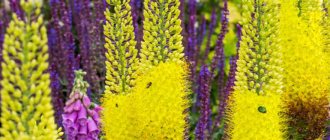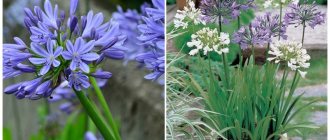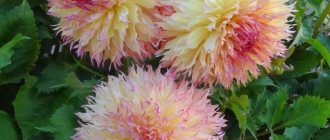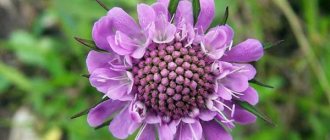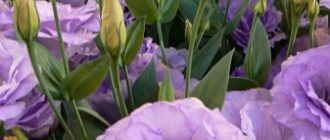Peony roses: Pixabay Peony roses are the result of a successful experiment by breeders, thanks to which gardeners received about 200 varieties of beautiful flowers. You can propagate hybrid roses at home. We plant an exclusive flower in the garden, having previously studied the secrets of growing and caring for it.
Description and photos of varieties
Constance Spray
This variety was the first to be bred and is in great demand today. The flower has large buds of a soft pink color. The bush is mature and can climb along a support. Roses bloom lushly and are distinguished by the presence of many fragrant buds.
Read about the original Spray border roses here.
Juliet
This variety is distinguished by brightly saturated double flowers with a pronounced scent. The bush is short - 1.5-1.8 m. It is advisable to grow the variety in partial shade.
Pat Austin
The variety has bright yellow-orange flowers. They are semi-double type, large in size with a delicate aroma. The variety is characterized by long flowering, which can last all summer. The plant resists cold and tolerates shade.
Benjamin Britten
The variety has large and double buds, their diameter is 10-12 cm. The color of the flowers is bright crimson. They emit a subtle and fruity aroma. Bushes of medium height - 1.5 m. The variety resists diseases and tolerates cold well.
Misty Bubble
The buds of this variety have a bright purple color, the aroma is reminiscent of oriental spices. Misty Bubble blooms profusely, and up to 5 flower stalks can form on one bush.
Lady Charlotte
This is a young variety that has a pleasant yellow color. The aroma is also delicate, but rich, reminiscent of a tea rose. The rose buds are large, terry type. Flowering is wavy and long lasting.
We talked about the variety of types and varieties of roses here.
Types and varieties of peony roses
There are only about 200 varieties of peony rose, but in the Russian climate it is irrational to grow most of them.
Austin rose is divided into 4 conventional types depending on the color of the buds. All types are divided into many varieties, among which there are several of the most common.
Pink peony rose
Pink is the most popular color among peonies, so it accentuates the extraordinary similarity of these flowers. The saturation of shades varies from delicate pink to bright fuchsia. This species has large round flowers with double petals. The most common varieties in gardening are the following.
Constance Spry
This rose belongs to the climbing varieties; it has a soft pink tint of buds. The shoots can reach a length of 6 meters, and it spreads up to 3 meters wide.
The densely double flowers of this rose bloom in inflorescences of 5-6 pieces, but do not open completely.
Eglantine
Shrub scrub rose. Features continuous flowering. It has a bright aroma with notes of oriental incense. This variety has low immunity and is therefore inconvenient for breeding.
Miranda
The bud of this rose has pink central petals and white outer petals. Very voluminous buds - up to 12 cm in diameter.
This variety has a delicate, barely audible fruity aroma with a hint of spring flowers.
Huntington Rose
This variety has the bright aroma of a real antique rose. In the process of breeding this rose, the breeder tried not to lose the unique aroma and external characteristics of the flower.
It has a gradient color - from light pink at the tips to rich pink in the inner part of the bud.
White peony rose
Pure white shades are quite difficult to achieve during the breeding process, so most varieties that are called white have various shades - cream, pink or yellow.
This species has few varieties and is very popular among rose fans. This rose is often used by florists when decorating weddings.
Tranquility
This variety has a yellow-white shade of petals and a rather large bud - up to 12 cm in diameter.
Flowers of an elegant round shape bloom in inflorescences of 3-8 pieces. Flowering occurs twice a season.
Snow Goose
The bushes of this variety of English rose are tall - reaching 3 meters. Snow Goose has small buds. Blooms almost continuously throughout the season.
Claire Austin
It has a fairly miniature bush - up to 1 meter in diameter. The flowers are round in shape and yellowish in color and grow three per stem.
This rose has a pleasant, but rather weak aroma.
Yellow peony rose
There are quite a few varieties of this type of English rose and they are very popular. Below we consider varieties that are more adapted to the climate conditions of our country.
Golden Celebration
This is a long-flowering variety with a compact bush - up to 1.5 m in diameter. The flowers are very large - up to 15 cm in diameter, have a bright aroma and a pastel honey-yellow color. This variety of peony rose is resistant to most types of diseases.
Graham Thomas
The variety has bright apricot-colored flowers and a voluminous bush. Large buds have up to 70 petals. It has high immunity and blooms throughout the season.
Pat Austin
This variety is distinguished by a very bright, orange bud color. The flowers are lush, large, with petals curved inward. This rose does not tolerate heat. Cut flowers immediately fall off.
Red peony rose
The Austin rose in red is the most classic look. These varieties of roses are used to decorate gardens and create floral arrangements.
William Shakespeare
A very common variety, famous for its unsurpassed beauty. It has a bright scarlet, densely double bud. Flowers are collected in inflorescences of 4 pieces.
Benjamin Britten
This rose variety has an unusual bud structure - the central petals are much smaller than the outer ones. Rose has a subtle fruity aroma, making it an attractive option for gardeners.
Othello
This rose is demanding to care for, but at the same time it is a very attractive variety. It has small raspberry buds and an exquisite aroma.
Darcey Bussell
It has a small bush. It can be planted not only in open ground, but also in pots. The buds have a rich crimson hue, and towards the end of flowering they become dark burgundy.
Ranunculus
Ranunculus, or Asian buttercup, is a wonderful counterpart to the peony. This plant is up to 80 centimeters high, with bright green leaves of dissected shape. Lush flowers with a diameter of 5-10 centimeters have a color characteristic of peonies - from soft pink to purple. White ranunculus is also found. Thin petals surround light green stamens in the center of the flower.
It blooms in June-July; some species decorate flower beds until autumn frosts. Features of growing ranunculus:
- grows well in sunny areas, but prefers partial shade;
- the soil is preferably light and fertile (sand drainage will be required);
- The easiest way to grow is by seedling method, sowing seeds in February;
- Seedlings are planted in open ground at the end of April or in May.
Suitable for growing in open ground, in pots and as a decorative element for closed terraces. An important point is that ranunculus juice is poisonous. Care must be taken when working with these plants, just as when cutting them for bouquets.
Features of caring for climbing peony roses
For health and good flowering, peony roses need a sufficient amount of sunny color.
As mentioned above, the peony flower shape has its drawbacks in the form of insufficient resistance to moisture. During prolonged rains, such roses cannot preserve and normally open a multi-petal bud. Therefore, one of the key measures for caring for peony roses is their protection from dampness.
To ensure that roses of this type suffer less from waterlogging and are not affected by fungi and rot, you must do the following:
- Ensure ideal bush aeration. There should not be any extra, thickening shoots on the lashes. It is not advisable to plant any other flowers in the tree trunk circle, which may interfere with the ventilation of the rose.
- Ensure proper watering. The soil should not be over-moistened (article ⇒ Rules for watering garden roses). During prolonged rains, the tree trunk circle can be mulched with a special non-woven material, which prevents the lower part of the bush from becoming dirty.
- Treat bushes with antifungal agents in a timely manner. The treatment plan can include fungicides such as Fitolavin, Profit, Oksikhom or Ridomil Gold.
- Fertilize roses with potassium and phosphorus. These elements contribute to the formation of a strong root system, healthy foliage and increase the resistance of buds to adverse environmental factors.
Care
There are quite a few different flowers that look very similar to peonies, but are not. You need to be able to distinguish between them in order to decide what care and necessary conditions to create, since they may differ. Peonies can grow for a long time without transplanting, especially if the place is well lit. After planting, you need to pick off the developing buds to create a strong root system. To grow strong side stems that will bloom in the future, faded buds must be removed without fail.
For wintering, roses, like peonies, are well covered, leaving them in the ground. Bulbs (peony-like daffodils and tulips) begin to bloom in the coming spring after planting. At the end of flowering (in summer), the bulbs are dug up, and in mid-autumn they are replanted.
The location of these plants should be well lit.
Asters belong to annual crops; their life cycle begins in early spring and ends with the onset of frost. When the inflorescence dries, the seeds are selected for subsequent propagation. In the spring they are sown, then the cycle begins again. In general, the Chinese peony aster is a picky plant, but it needs bright light, otherwise the stems will be too thin.
Eustoma is a biennial plant. In the first year of life it forms a rosette, and begins to bloom the next year. In winter, it needs thorough shelter or digging. In the spring it is planted again on the site. The soil needs to be light, with good drainage. The flower reproduces only with the help of seeds. Chrysanthemums overwinter in open ground, but require good cover.
The “Shabo” carnation is also dug up for the winter; it does not tolerate frost well. Well-lit areas are suitable for planting. Ranunculus is planted in a shaded area after the threat of frost. In autumn, the roots are dug up and stored in cool rooms. This plant is also grown as a houseplant; a lush bush of several specimens in one container looks beautiful. In order for the plants to have a healthy and strong appearance, and for the buds to be bright, they need to be provided with the necessary care:
- regular hydration;
- loosening the soil to allow air access to the roots;
- mulching to retain soil moisture;
- spring fertilizing with nitrogen fertilizers;
- garter of elongated plants;
- cutting off faded buds to stimulate the formation of lateral stems;
- At the first signs of disease or pest damage, plants are treated with special preparations.
Experienced flower growers advise trimming side shoots and inflorescences if the flowers will then be cut. Then the plant will concentrate all its forces on the main stem. Flowers similar to peonies look spectacular in flower beds, mixed borders or front gardens. They can be placed monochrome, but they also look great in compositions with other plants . No matter how peony flowers are planted, they will always be a charming decoration for any planting.
An overview of peony flowers can be seen in the following video.
Red varieties
Burgundy, red, purple and crimson. The variety of shades is amazing. Everyone will find peony roses to suit their taste.
Tradescant
It has an unusual purple-carmine color. Very deep and rich. The flower size is about 7 cm. The bush is round, up to 75 cm in height and width.
William Shakespeare
A very famous and popular variety. Very dense flowers, up to 8 cm. There are about 4 flowers in the inflorescence. Red peony roses look amazing, including this variety, beautiful in every way.
Benjamin Britten
Bright red flowers of interesting shape. The rose is cupped, but it appears as if the round bowl of larger petals is filled with smaller petals. A fairly pronounced aroma and a compact bush make this variety desirable for every garden.
Pat Austin
Light peach flowers with a pronounced aroma. Not demanding on growing conditions. Double flowers bloom all summer.
Othello
A medium-sized bush with roses the color of ripe raspberries. They bloom all summer and have a distinct aroma. Demanding on lighting and wintering conditions.
Yellow aspen hybrids
Yellow roses are a symbol not only of imminent separation, but also of friendliness and happiness. There are many peony-shaped roses of this shade.
Graham Thomas
Roses Cordes
A variety with medium-sized double flowers, which form inflorescences of 5-6 pieces. The color of the petals is bright yellow, rich. The rose aroma is pleasant, but weak.
Bushes of the Graham Thomas variety reach 1.5-3 m in height. The hybrid is resistant to infections and cold temperatures, which explains its popularity.
For your information! Graham Thomas is one of Austin's finest roses. Blooms all season.
Golden Celebration
Rose Golden Celebration is a tall, spreading variety with large, strong-smelling honey-colored buds. The diameter of the flowers is 16 cm. The flowers form clusters of 5-6 buds.
Hybrid bushes grow up to 180 cm in height and 120 cm in width. The stems of the plant are curved in the shape of a parabola.
Golden Celebration
Description of peony rose
Peony roses were bred by the famous breeder D. Austin at the end of the last century. That's why they were originally called Austin roses. These extraordinary shrubs differ from other representatives of the species by their unsurpassed beauty, variety of colors, resistance to various diseases and pests, as well as high decorative qualities.
Flowers that look like peonies are quite unpretentious. The shrub grows quickly without requiring additional feeding or special care. Many varieties are successfully grown in greenhouses, creating an excellent alternative to peonies throughout the year.
Peonies and peony roses themselves are very similar in appearance. Some varieties even have an identical structure, especially when it comes to the flower itself. But they still have differences. As a rule, peony roses have a rosette, pomp-shaped or cup-shaped inflorescence. Some varieties have a stunning, refined aroma that intensifies in cloudy weather.
The bush grows quickly, forming a dense crown with bright fragrant flowers. Roses similar to peonies, the names of which are listed below, are widely used for landscaping park areas, gardens and summer cottages, creating wedding bouquets, and also as decoration when decorating a hall for celebrations.
Varieties of roses similar to peonies
Among the numerous varieties and varieties of these beautiful flowers, the most popular ones can be noted. These plants are most often used to create unique bouquets, as well as landscape design. Roses, like peonies, whose names are known to most gardeners, are extremely popular.
What are the names of roses that look like peonies?
- Constance Spray. This is the very first hybrid of a peony-like rose. It has large, pale pink, cup-shaped flowers. The shrub is vigorous, its height can reach 4 meters, which allows the plant to be used as a hedge, running it along a low fence, wall or support. The bush is abundantly covered with huge flowers, which never fully open, remaining in the state of a half-bud. The plant has matte pale green foliage and frequent small thorns.
- Othello. It has densely double large flowers, painted in a rich crimson color, which over time turns into purple-lilac. At the same time, the inflorescences look so dark that it is not difficult to imagine why this rose variety received this name. A medium-sized shrub with a large number of thorns, it is characterized by repeated flowering and does not tolerate heat. Flowers collected in brushes remain fresh for a long time, so they are often used for cutting.
- Pat Austin. The variety grows well in partial shade and is resistant to cold. Large semi-double flowers are painted in a bright copper color, gradually turning into a soft cream shade. Flowering begins early, continues continuously and for quite a long time. The aroma is reminiscent of rose oil.
- Austin Gertrude Jackipp. A vigorous bush rose, characterized by abundant and long-lasting (from May to November) flowering. The aroma is reminiscent of old roses with delicate notes of myrrh. Bright pink double flowers, evenly distributed throughout the bush, completely cover it. The variety is distinguished by its full flowering and decorative appearance. The plant is resistant to various diseases and tolerates winter well. An adult bush reaches a height of 250 cm, its diameter is about 1 meter.
- Benjamin Briten. The beautifully leafy shrub reaches a height of 1.4 m (under favorable conditions - up to 2.0 m). Raspberry flowers with a diameter of about 12 cm exude a pronounced fruity aroma. Densely double buds, collected in inflorescences, have a cup-shaped shape. Even weakly flowering plants of this variety look very powerful. Peony roses are highly resistant to pests and various diseases. Recommended for growing in flower beds, where it is possible to cross them with other varieties to obtain a more delicate shade.
- William Shakespeare. The bush is distinguished by peony-shaped flowers that exude the scent of ancient roses. The height of the plant reaches 180 cm. The shrub grows well in the shade and is unpretentious in care.
- Brother Cadfil. Among other English varieties of peony roses, it stands out for its rather large pink flowers. Looks very impressive in the center of the composition. The impressively sized flowers retain their freshness for a long time and look quite neat. Rose Brother Cadfil is proportionally built and practically devoid of thorns.
Classifications of roses according to various characteristics
| Austin roses that have received the Brynn Royal Horticultural Society seal of approval: |
|
| Varieties recommended for cultivation in Russia |
|
| Varieties that can be grown as climbers |
|
| Varieties for container growing |
|
| Varieties with continuous flowering |
|
| Varieties with very large flowers |
|
| Varieties that do not require support when growing |
|
Ancient and modern varieties of roses
Roses are grown in the park and garden. Park roses include decorative roses and hybrids grown on rosehip rootstock. They withstand cold well and are suitable for breeding in northern regions. There are many garden varieties: there are subtropical and hybrid tea, peony roses: bush, climbing and climbing. They require special care and good shelter for wintering. Among garden plants, ancient and modern species are distinguished.
Ancient varieties
Old varieties include:
- Alba or white rose is a tall, upright bush that bears double pinkish or white buds and blooms once a year. The plant is resistant to frost and disease. As early as the 14th century, he was depicted on the coats of arms of York.
Bourbon is a remontant shrub with thick shoots, shiny oval leaves and fragrant double flowers: white, pink or red. Types of roses can be erect or climbing. They were grown on the island of Bourbon in the Indian Ocean, then “emigrated” to France.
Centrifolal - centrifugal or Provencal. The bush is not tall, but spreading, there are thorns and double flowers that emit a characteristic smell. The colors are white, pinkish and deep pink, less often yellow, striped or spotted. There are always a lot of flowers on the shoots, but they please the eye only once a season.
Damascus - a resident of the Middle East, which was spread throughout the world by the Romans and Crusaders. The tall bush has drooping shoots with thorns. Its Kazanlak variety in Bulgaria became the source of the famous rose oil. Autumn Damascus is bred more often due to its double flowering.
Hybrid rose Gallica, which is descended from the Gallic rose hip. Refers to an old European variety, which was grown as a medicinal plant by monastic flower growers at monasteries. The shrub is low-growing, but spreading with the presence of fragrant simple or densely double flowers: pink, red, purple, crimson or striped.
Mossy - with strongly drooping shoots and sepals. It received its name in connection with the specific woody smell from the glandular hairs covering the petals, like moss. The shrub is low or medium tall, blooms twice. Based on this species, miniature varieties of roses were bred: decorative varieties Fairy Moss.
Chinese is a remontant shrub with smooth shoots with sparse thorns, simple or densely double small buds, blooming twice a season. Their petals are unique: they do not fade in the sun, but darken. Continuously flowering varieties emerged from the Chinese one: Bourbon, Noisette and others.
Carnations
Terry varieties of garden carnations resemble peonies in appearance. Translated from Greek, carnation means “flower of Zeus.” Flowers grow singly or in bushes, with 2-3 inflorescences on each. The flowers are lush, velvety, with a terry border along the edges of the plates. The color can be almost any. The leaves are green, with an unusual grass-like shape.
Features of growing cloves and caring for them:
- propagated by seeds and layering;
- there are annual and perennial varieties;
- perennials are replanted every 5 years;
- Feeding with humus is applied once a year, after flowering;
- grows well at higher elevations;
- Watering is moderate, the plant does not like excess moisture.
Carnations are grown not only for cutting. They are used as a design element for rock gardens, borders and retaining walls.
Peonies are beautiful and bright flowers, but rather capricious to grow. But there are more unpretentious plants that are similar in appearance. These include peony roses and poppies, ranunculus, and double varieties of carnations. They do not require complicated care, but sometimes it is difficult to distinguish them from real peonies by their appearance.
Varieties of peony roses
There are quite a lot of peony roses, about 200 species, they have a wide variety of colors and shades. Roses are conventionally divided into small subspecies:
- pink;
- yellow;
- white;
- red.
Pink varieties
The most common types of roses are pink peony roses.
Constance Spray
This is the first variety that was bred in England in the 90s. Its distinctive feature is the large size of the terry buds, the size of which reaches 14 cm.
Eglantine
Branched bush up to 1.5 m high with matte foliage. It has pale pink, cup-shaped flowers with a twisted rosette and petals slightly curving at the edges. They grow in clusters of 6-9 pieces bending towards the ground.
Miranda
Miranda's flowers are pink inside and soft pink on the outside, close to white. They are large in size - 10-12 cm in diameter. They do not have such a bright aroma as most peony roses; this hybrid has a lighter scent. The bush does not form inflorescences, so the flowers are convenient to use for making bouquets.
White varieties
There are not many white varieties, but their popularity is also high. They are often used by florists to create wedding bouquets.
Snow Goose
A voluminous bush growing up to 3 m in height. The flowers on it are small in size and do not fade for a long time. Their flowering continues throughout the season. They have a creamy white color, quickly fade in the sun and become snow-white. The foliage is small, shiny, and has few thorns. Average resistance to powdery mildew and black spot.
Tranquility
The Tranquility variety is re-blooming, its inflorescences are up to 12 cm in diameter. In the center of the flower the petals grow creamy with a yellowish tint, and towards the edge they become white. The height of the bush reaches 1.2 m.
Claire Austin
This variety is deservedly considered the most beautiful of all, so it was honored to bear the name of the dearest person to the creator of these roses, David Austin's daughter Claire Austin.
The variety belongs to scrub roses, which are large in size and have an abundance of flowers. The bush is spreading, with a height of 1.5 m, the width is about 2 m. Also, these peony roses are often grown as climbing roses. In this case, thanks to the support, the bush reaches 3 m in height. Looks great on arches.
Yellow varieties
Yellow varieties have a variety of shades. The varieties described below are perfectly adapted to the climatic conditions of Russia.
Graham Thomas
The hybrid was bred in 1983 and is now one of the most popular varieties. Graham Tomos flowers are double flowers with a bright yellow color and a peach tint. The diameter of the inflorescences is up to 10 cm. Flowering occurs all summer, first abundantly, and then more moderately. They have a bright sweet aroma.
In cold climates they can grow up to 1.5 m, and in warm conditions they can reach 3 m.
Golden Celebration
The hybrid has large lush buds, the diameter of which reaches 16 cm. Flowers grow in inflorescences of 3-5 pieces. There are many thorns on the bushes, curved in an arc. The variety is resistant to diseases. Blooms all season. The color of the flowers is honey-yellow.
Pat Austin
The hybrid is named after David Austin's wife. It appeared after crossing two varieties, the pink-apricot Abraham Derby and the bright yellow Graham Thomas. The result is a bright, eye-catching orange-bronze color. As roses age, the color gradually fades and turns coral or pink. The inner petals of the variety are bent inward, and the outer petals, on the contrary, are turned inside out.
Red varieties
Red hybrids are among the brightest of the peony roses. They decorate greenhouses and garden plots. Often used in bouquets.
Tradescant
The variety has an unusual deep purple-carmine color. The diameter of the flowers is about 5-7 cm. The height of the bush is 75 cm in both height and width. Roses are also grown as a climbing plant. The Tradescant hybrid has the title of best modern scrub of the American Rose Society AARS 1999-2000.
William Shakespeare
One of the most famous flowers among peony roses, having dense purple petals with a flower diameter of up to 8 cm. In inflorescences there are up to 4 flowers. The bush has good winter hardiness, but is susceptible to fungal infections.
Benjamin Britten
The bushes of this relatively new variety have a powerful, branched structure. The height of the plant ranges from 90 to 140 cm. The variety grows quickly, is resistant to disease and frost, and is easy to care for. Benjamin Britten flowers have a bright fruity aroma with hints of wine and pears. Flowering occurs twice, the first time in June, and the second time in late August or early September.
Othello
During flowering, roses fully open and appear heavy and large. The height of the bush reaches approximately 120 cm. If the conditions are not favorable enough, it grows wider, but can only reach 80 cm in height.
Diseases and pests
Most varieties of English Austin rose are disease resistant. But the bushes may be affected by powdery mildew, black spot and rot.
If signs of damage appear, immediate intervention is required.
To prevent these problems, a suitable preparation should be used for prophylaxis up to three times during the growing season.
The peony rose is attractive to chafers, aphids and spider mites. To control pests, you can use a solution of soda, soap or potassium permanganate, and also purchase industrial products.
Top dressing
An essential part of caring is the use of nutrients. It is worth noting that transplants that have reached one year of age are fertilized. A variety of additives are applied three times throughout the entire season, repeatability is four weeks.
Begin feeding before the birth of flowers with preparations containing nitrogen. Further enrichment of the soil composition involves organic matter and complex fertilizers.
To prepare individuals for wintering, the land is fed with resources containing phosphorus and potassium.
Adult representatives also need additional diet. What kind of feeding is there:
- compost of rotted consistency;
- fermented cow manure, previously diluted;
- infused chicken manure, used in an aqueous solution of 1:25;
- ready-made mineral mixtures;
- wood ash;
- bone meal;
- compositions of folk recipes.
Any organic matter must be fresh. Mid-August is the time of the last feeding.
Landing rules
All types of roses are characterized by simple cultivation, but despite this, they have a “capricious” character. Climbing varieties are no exception. This species is demanding in terms of planting and care, so before growing these flowers you should take into account the recommendations of experienced gardeners and adhere to certain rules. The location of the rose garden plays a huge role. The area should be moderately illuminated by the sun and protected from gusts of wind. You cannot plant bushes in open areas, as at lunchtime they will not be shaded and may die from burns.
It is not advisable to decorate the corner parts of the building with roses, since they will be subject to the harmful effects of drafts. The most optimal place for planting crops is considered to be garden plots located on the south side of buildings.
Before planting roses, regardless of the type of soil (with the exception of sandy), the hole is drained by filling it with expanded clay or sand. When planting seedlings in the spring, in order to speed up their adaptation, the root system is pruned by 30 cm and the shoulder straps are shortened by 20 cm. Such roses should be placed in areas protected from the wind, creating greenhouse conditions for them - the ground is covered with film on top.
Selection and storage of seedlings
Planting climbing roses should begin with the purchase of high-quality seedlings, since the growing process and the health of the future ornamental plant will depend on them
When purchasing planting material, experts advise paying attention to every little detail. First of all, this concerns the root system. If it is open, then preference should be given to samples with healthy and well-developed roots that show no signs of damage.
In the case when a seedling with a closed rhizome is purchased, the shoots are carefully examined. It is advisable to choose plants up to 70 cm high that have two strong, woody stems
If it is open, then preference should be given to samples with healthy and well-developed roots that do not show signs of damage. In the case when a seedling with a closed rhizome is purchased, the shoots are carefully examined. It is advisable to choose plants up to 70 cm high that have two strong, woody stems.
In addition, you need to purchase planting samples that are dormant (without buds or green shoots). They will take root better and get stronger by winter. Saplings with pale or light-colored shoots are not suitable for planting, as they were grown in poor conditions with insufficient lighting. Purchased bare-rooted seedlings should be placed in a container of water before planting, this will allow them to be well saturated with moisture. Roses with a closed root system are placed in a cool place, having previously treated the roots with a growth stimulator.
Disembarkation time and place
Climbing roses, like any other varieties, should be planted according to general rules. The optimal time for planting is considered to be autumn. Plants planted on the site in the fall are distinguished by good health, good growth and begin to bloom earlier. Depending on the climatic conditions of the area where the site is located, planting can be carried out from late September to early October. Thus, the rose has time to take root well before the first frost and continues to grow actively in the spring without adaptation.
The choice of place for planting roses also plays a huge role. To do this, it is worth taking into account the characteristics of the variety, the length of the shoulder straps and the spreading nature of the bush, since the plant is perennial and will grow on the site for decades. In order for the crop to quickly adapt, it is not recommended to choose areas where the soil has high alkalinity and acidity. You should also avoid areas with difficult terrain and close proximity to groundwater. In addition, the flowers must receive good lighting; for this they need to be planted in places where the sun's rays will reach most of the day, excluding the north side.
The rose garden should also be located at a distance of 60 cm from the walls of residential buildings and fences, with a step of 100 cm or more between the bushes. The selected area is covered in advance and the condition of the soil is assessed. If it is too clayey and heavy, then peat and sand are added to it, and additional compost or manure is added. For areas with a high level of acidity, it is necessary to make an adjustment by adding lime or ash to the ground. Sawdust is suitable for alkaline soil.
Shelter for the winter
In areas with cold climates, roses need to be covered for the winter. To do this, you can use dry leaves, straw or sawdust.
Important! Under no circumstances should you cover the bushes with film, as this will limit the supply of oxygen to the plant and lead to its death.
Peony roses are distinguished by a high degree of decorativeness, which is achieved due to the cup-shaped buds and compact shape of the bush. In addition, the undeniable advantages of Austin roses include a rich color palette, resistance to many diseases, ease of care, and rapid growth. The only pronounced drawback of these plants is the weak frost resistance of many varieties. However, this is a small price to pay for the pronounced intoxicating aroma and delightful appearance of peony roses.
Now, having learned about the different varieties of peony roses, it will be easier for the gardener to choose one or another type. White, pink, red queens of the garden will decorate any area. The main thing is to choose a variety suitable for the region and carry out proper planting and care!
0 0 votes
Article rating
How to grow and care for standard roses (with video)
Standard roses in the photo
Large-flowered, multi-flowered, climbing, repeat-blooming shrub and miniature species are suitable for forming roses in standard form. Almost every group of roses has varieties suitable for growing on a standard.
The height of the stem can be different - from 80 cm for a large-flowered rose to 125 cm for a climbing rose. Climbing roses form weeping standard forms. The crown and trunk of a standard rose are, respectively, a scion and a rootstock. The varietal scion is grafted onto the rootstock at least three times to create a beautiful and regular crown of a standard rose.
Standard roses in landscape design look very good in a small amateur garden; they create a pleasant romantic atmosphere.
All standard roses must be tied to stakes. As practice shows, it is not easy to plant and grow a standard rose, which is why they cost more than ordinary bush forms. Caring for standard roses must be skillful, including mandatory pruning and protection of the grafting site during the winter cold.
During cultivation, most standard roses are pruned like bush roses. Weeping standard roses are climbing varieties grafted onto rose hips at a height of about 1.5 m. In the spring, their old shoots are completely removed, and young shoots are shortened by a third. If this is not done, they will become too long and the bush will lose its shape.
When growing standard rose seedlings in the garden, the main thing is to get an even and strong rosehip standard! The higher it is, the better. It is not difficult to grow rose hips for rootstock if you know a number of features. Here they are: rose hips for sowing must be collected brown in mid-August, the seeds isolated from them and immediately sown in moist soil without stratification. In dry weather, crops are watered. In the spring, rosehip emerges and grows until autumn. From fully ripened rose hips, shoots will appear only in the second spring.
In the autumn, after leaf fall, rosehip seedlings are dug up, sorted, the largest ones are selected and planted according to a 150x20 cm pattern. Wide row spacing is done so that there is then enough land for hilling up the occultants for the winter.
Rose hips are grown for 4 years. All this time it is watered, loosened, sprayed against diseases and pests. In the 5th year from the root, it produces strong, even shoots of renewal, and then all the side branches are removed, except for one best shoot, which at the end of July, when it reaches 1.5-2 m, is pinched for lignification.
In mid-August, the rootstock is budded with different varieties, 4-5 buds each at a height of 120-150 cm. Each branch on the trunk is budded at the base. The bushes grown from these buds branch better and are not broken down as much by summer winds as those that grew from buds grafted onto the trunk itself.
Good seedlings with a weeping form are obtained from polyanthus and groundcover roses with thin, flexible shoots that reach down to the ground. They are very disease resistant and winter well.
After the leaves on the rose hips fall in the fall, the oculant trunks are tilted along the row, tying them at the soil surface to the bases of other trunks, and covered with soil from the inter-row spaces.
In the spring, the plants are opened and tied to installed supports made of two wires along the row, as in a vineyard. The rosehip is pruned at the bud, and by autumn well-developed seedlings grow.
In total, it takes 7 years to grow a rose in standard form, starting from rosehip seeds. In a permanent place, such roses are planted at a distance of 120 cm from each other, and weeping forms - 180 cm.
It is good to use bamboo stakes for support; they are durable and beautiful.
When planting standard roses, keep in mind that for the winter they will have to be tilted to the ground and covered; provide a place for this.
The soil around the boles must be mulched with humus, chopped straw or sawdust to retain moisture, because uncovered soil dries out quickly. Water and loosen the soil under standard roses more often than under ordinary bush roses. It is necessary to water without allowing water to get on the leaves, that is, not by sprinkling, but by pouring it into the hole of the trunk circle. Drops of moisture on the leaves, especially in the second half of summer, contribute to the intensive development of fungal diseases.
Watch the video on how to grow a standard rose to better understand how such a plant is formed:
Description and photos of varieties
Constance Spray
This variety was the first to be bred and is in great demand today. The flower has large buds of a soft pink color. The bush is mature and can climb along a support. Roses bloom lushly and are distinguished by the presence of many fragrant buds.
Juliet
This variety is distinguished by brightly saturated double flowers with a pronounced scent. The bush is short - 1.5-1.8 m. It is advisable to grow the variety in partial shade.
Pat Austin
The variety has bright yellow-orange flowers. They are semi-double type, large in size with a delicate aroma. The variety is characterized by long flowering, which can last all summer. The plant resists cold and tolerates shade.
Benjamin Britten
The variety has large and double buds, their diameter is 10-12 cm. The color of the flowers is bright crimson. They emit a subtle and fruity aroma. Bushes of medium height - 1.5 m. The variety resists diseases and tolerates cold well.
Misty Bubble
The buds of this variety have a bright purple color, the aroma is reminiscent of oriental spices. Misty Bubble blooms profusely, and up to 5 flower stalks can form on one bush.
Peonies and ranunculus: differences and similarities
Who would have thought that the Asian buttercup could compete with the royal double flower. But in floristry everything is possible. Especially Dutch unopened peonies resemble ranunculus. Both plants have dense, round buds.
Blooming ranunculi are approximately 6 cm in diameter.
On the one hand, this is not much compared to 10-12 cm for peonies, but they are cheaper. Buy a few dozen of them and you'll end up with a huge armful. For a girl, this can be a truly original and unusual gift. According to the observations of Semitsvetik florists, men often give familiar flowers; for them, ranunculus is an exotic thing that they underestimate.




